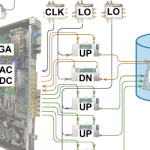Quantum sensor using superposition opens ‘a New Window into the Underground’

(Vice) Becky Ferreira, a contributor to Vice writes about the University of Birmingham’s development and real-world testing underground of a quantum gravity sensor. Inside Quantum Technology summarizes here.
A team of physicists and engineers at the University of Birmingham have successfully tested a quantum sensor that can probe underground structures by harnessing the physics that governs atoms and gravity, according to a new study.
This type of sensor, known as a quantum gravity gradiometer, has been successfully tested before in laboratory conditions, but the new research reports the first demonstration of the instrument in a practical outdoor setting, a breakthrough that paves the way toward a host of improved sensing applications in fields as diverse as archeology, navigation, urban planning, and disaster preparation.
Michael Holynski, a physicist and senior lecturer in the Cold Atoms research group, developed a novel gradiometer that sensed a tunnel buried three feet beneath a road in Birmingham, which is exactly the sort of noisy vibrational environment that has scuttled the practical performance of quantum sensors in the past.
Researchers have developed a range of tools to map out underground spaces without physically digging into them, but gravity sensors have the potential to peer even deeper into Earth and assess a wider range of environments, such as ancient tombs, mine shafts, or water aquifers. These sensors manipulate the quantum properties of atoms to measure minute variations in gravitational fields, a technique that can reveal the contours and properties of subterranean areas in urban areas.
“Vibration is relevant for all gravity sensors,” explained Holynski. “It doesn’t matter how sensitive they are, or how they’re made—we can’t distinguish between gravity and vibration.”
To overcome this problem, Holynski, Metje, and their colleagues at the UK National Quantum Technology Hub in Sensors and Metrology, developed a gradiometer that leverages the quantum phenomenon known as superposition in which an atom can occupy two states at once.
The team’s instrument fires a laser pulse at clouds of cold atoms separated vertically by three feet. This initial trigger prompts some of them to enter a state of superposition where one version of the atom has absorbed the pulse, generating momentum, and one has not. A second pulse causes the atoms to switch these conditions so that the atom that initially avoided the pulse now absorbs it, and vice versa, and a third pulse brings them back to the original state.
This method, known as atom interferometry, allows the researchers to measure the difference between the trajectories of the atoms, which reveals minute variations in the gravitational field of masses below them. Because the two clouds of atoms are excited by the laser pulses at the exact same time, they encounter the same vibrational noise but record different gravitational signals because they are at different elevations, which enables researchers to isolate the gravitational data from the vibrational feedback



















